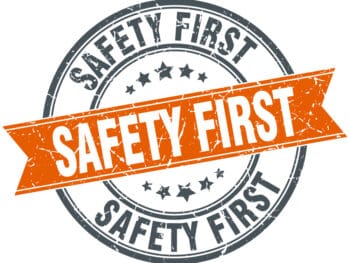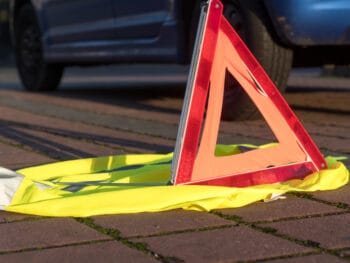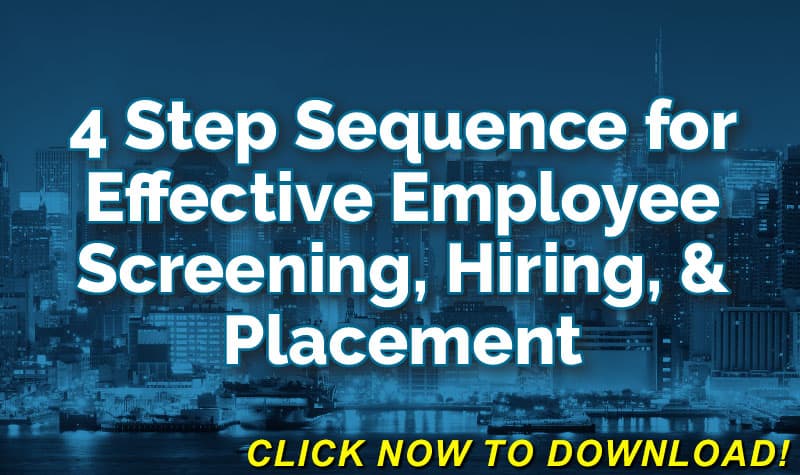
That’s good news for companies that don’t want to lose the benefits of older workers — institutional knowledge, lower turnover, more dedication to work, and positive values. However, while older workers also tend to have fewer workplace injuries, they generally take longer to heal. Savvy employers know they must take steps to address changes related to the aging process.
The Problems
Our bodies generally show signs of aging around ages 40 to 50. Not all older workers have the same physical or mental issues associated with aging, but there are often changes that impact vision, hearing, strength and flexibility, and cognitive skills.
Older workers tend to experience more problems with their backs, shoulders, knees and trunks, while younger workers are more likely to have head and hand injuries.
Click Link to Access Free PDF Download
“4-Step Sequence For Effective Employee Screening, Hiring, & Placement”
The risk of falling also increases with age. Workers in their early 20s had about 8 percent of the fatal falls in 2014, while those in the 55 to 64 age group had 20.7 percent, and those over 65 had a fatal fall rate of 27.3 percent.
Cumulative trauma disorders related to ergonomic issues also tend to be heightened among older workers.
What to Do
Employers cannot single out older workers — or any employees — for health-related changes without running the risk of discrimination allegations, unless it is an accommodation for someone with a disability as defined by the Americans with Disabilities Act. But changes can be made that will make all workers safer. The primary ones focus on physical changes to the workplace and changes to job design.
Before undertaking any changes, it is wise to get input from workers — of all ages. While managers may think they know what might improve health and safety, those doing the jobs on a daily basis have much better insight. Plus, getting the help of workers will better ensure their buy-in.
Work environment
- Turn up the lights. Put adequate lighting in all areas — inside and out, to make sure surfaces are clearly visible. Change burnt out bulbs as soon as possible. Table lamps should be set so the bottom of the lampshade is at the eye level of the person using it. You can also help workers see better by supplying magnifying lenses, larger computer typeface, and screens to cut down on glare. Having contrasting colors on ramps and stairways will help workers see them better.
- Maintain good housekeeping. Get rid of clutter and have a policy that requires workers to move boxes or other objects out of normal walking areas when not in use. Walkways should also be free of electrical cords and other objects that could cause an employee to trip and fall.
- Turn down the noise. Implementing a hearing conservation program is best. Where possible, sound dampening materials should be placed in areas with loud noises. Alternatively, provide sound-reducing headphones; but make sure any warning bells or alarms have visual as well as auditory alerts.
- Solid footing. All walking surfaces should be kept dry. Paper towels should be available near doorways and other areas where water, snow or ice may be tracked. If an area is perpetually wet, make sure there is adequate signage. Provide mats and slip-resistant shoes for workers in areas where there may be grease or slippery surfaces. If possible, use flooring material that is easier on the knees and hips — such as wood instead of concrete.
- Assistive devices. Manual hoisting cranes are a great way to help reduce back strain and prevent musculoskeletal problems. Automating processes where possible will also help reduce strain on the body.
- Adjust work stations. Make sure workers are comfortable and are properly situated in their chairs and at their desks. If possible, have an ergonomist survey the area and make recommended changes.
- Make sure equipment is always in proper working condition and that safeguards are fully operational. If your employees drive company vehicles, make sure to adhere to the manufacturer’s maintenance schedule. Also ensure tires are properly inflated and washer fluid is always available.
Job Design
- Take a break. Allow workers to take more frequent, short breaks where possible, to allow the body to reenergize.
- Rotate jobs. When feasible, allow for job rotation across workstations to balance the loads on workers’ bodies. It also helps reduce repetitive motions, which can cause pain.
- Schedule changes. Revise schedules if needed to ensure workers do not handle strenuous tasks for long periods of time. Make sure a worker is able to perform any task before assigning it.
- Workers who have more autonomy are more productive. Allow employees to work from home when possible, and/or work during non-traditional hours.
Conclusion
Making some common-sense changes with the help of employees at all levels of the organization is an easy way to prevent injuries among all workers, especially older ones. Companies that do so see increased productivity and money saved on their workers’ compensation and healthcare budgets.

Author Michael Stack, Principal, COMPClub, Amaxx LLC. He is an expert in workers compensation cost containment systems and helps employers reduce their work comp costs by 20% to 50%. He works as a consultant to large and mid-market clients, is co-author of Your Ultimate Guide To Mastering Workers Comp Costs, a comprehensive step-by-step manual of cost containment strategies based on hands-on field experience, and is founder of COMPClub, an exclusive member training program on workers compensation cost containment best practices.
Contact: mstack@reduceyourworkerscomp.com.
Workers’ Comp Roundup Blog: https://blog.reduceyourworkerscomp.com/
Live Stream WC Training: http://workerscompclub.com/livestreamtraining.com
©2017 Amaxx LLC. All rights reserved under International Copyright Law.
Do not use this information without independent verification. All state laws vary. You should consult with your insurance broker, attorney, or qualified professional.







